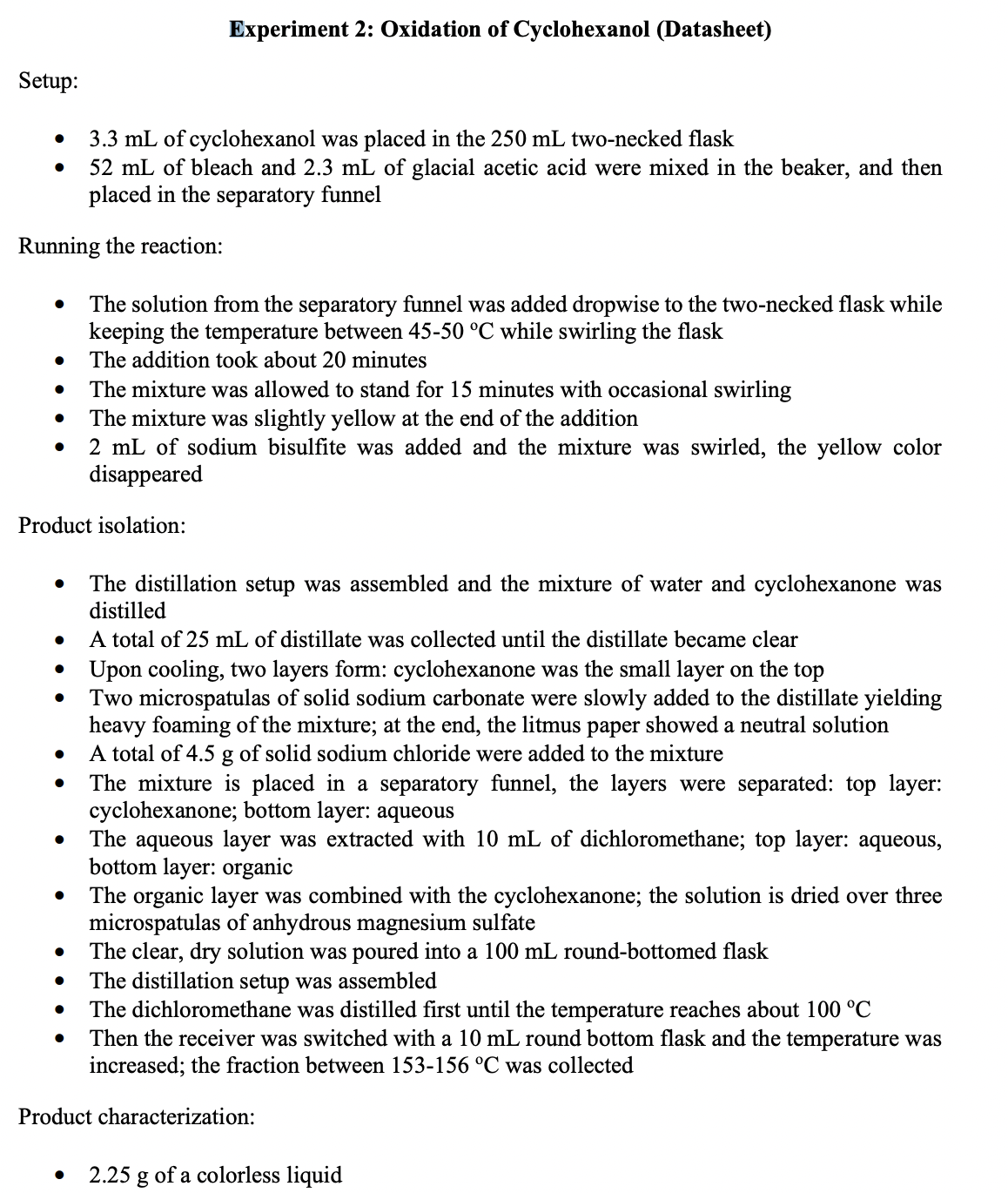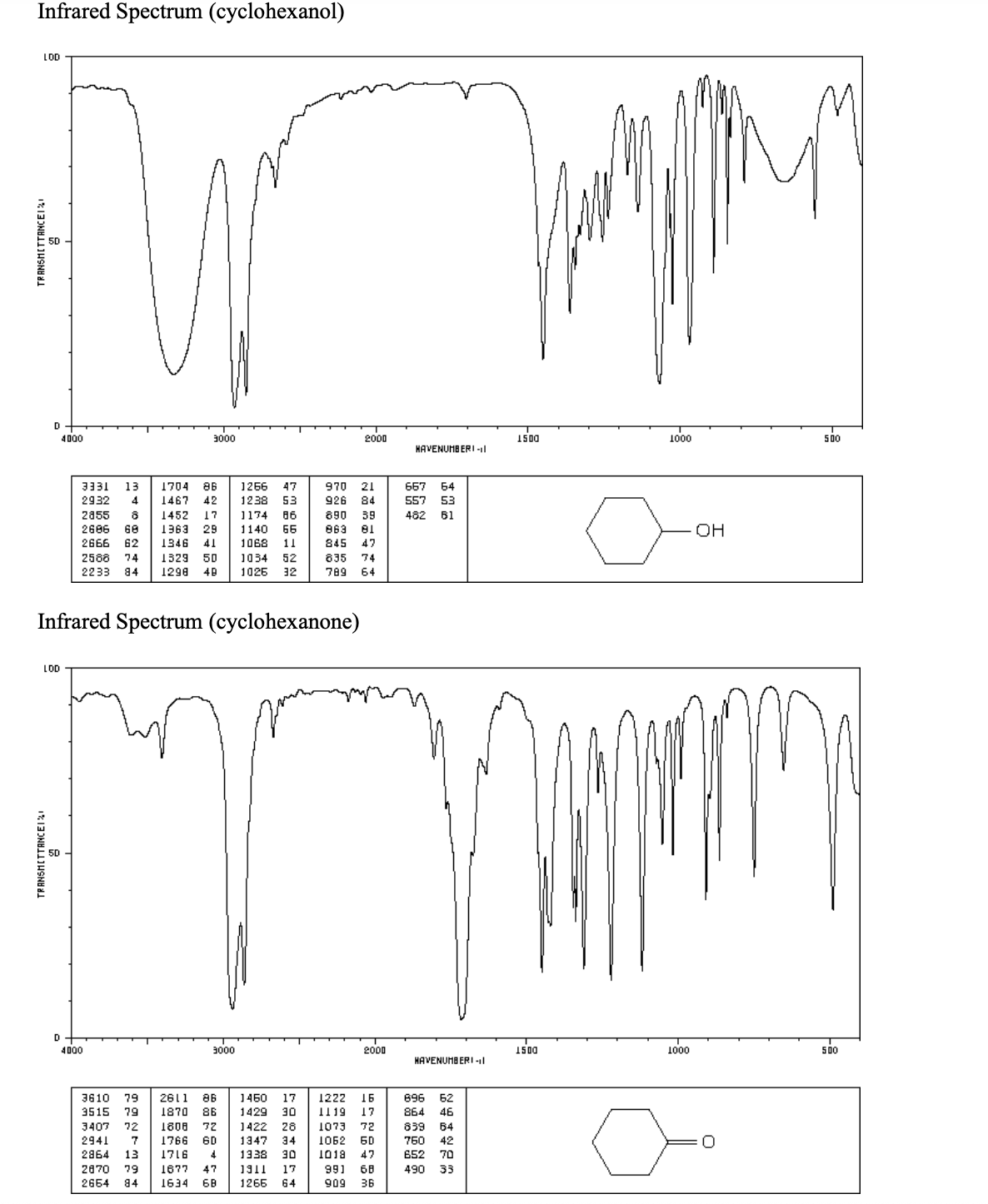Chemistry
10th Edition
ISBN:9781305957404
Author:Steven S. Zumdahl, Susan A. Zumdahl, Donald J. DeCoste
Publisher:Steven S. Zumdahl, Susan A. Zumdahl, Donald J. DeCoste
Chapter1: Chemical Foundations
Section: Chapter Questions
Problem 1RQ: Define and explain the differences between the following terms. a. law and theory b. theory and...
Related questions
Question
based on the data and information below how do I calucalted the experimental percentage yield? what is the experimental percentage yield?

Transcribed Image Text:Experiment 2: Oxidation of Cyclohexanol (Datasheet)
Setup:
3.3 mL of cyclohexanol was placed in the 250 mL two-necked flask
52 mL of bleach and 2.3 mL of glacial acetic acid were mixed in the beaker, and then
placed in the separatory funnel
Running the reaction:
The solution from the separatory funnel was added dropwise to the two-necked flask while
keeping the temperature between 45-50 °C while swirling the flask
The addition took about 20 minutes
The mixture was allowed to stand for 15 minutes with occasional swirling
The mixture was slightly yellow at the end of the addition
2 mL of sodium bisulfite was added and the mixture was swirled, the yellow color
disappeared
Product isolation:
The distillation setup was assembled and the mixture of water and cyclohexanone was
distilled
A total of 25 mL of distillate was collected until the distillate became clear
• Upon cooling, two layers form: cyclohexanone was the small layer on the top
Two microspatulas of solid sodium carbonate were slowly added to the distillate yielding
heavy foaming of the mixture; at the end, the litmus paper showed a neutral solution
A total of 4.5 g of solid sodium chloride were added to the mixture
The mixture is placed in a separatory funnel, the layers were separated: top layer:
cyclohexanone; bottom layer: aqueous
The aqueous layer was extracted with 10 mL of dichloromethane; top layer: aqueous,
bottom layer: organic
The organic layer was combined with the cyclohexanone; the solution is dried over three
microspatulas of anhydrous magnesium sulfate
The clear, dry solution was poured into a 100 mL round-bottomed flask
The distillation setup was assembled
The dichloromethane was distilled first until the temperature reaches about 100 °C
Then the receiver was switched with a 10 mL round bottom flask and the temperature was
increased; the fraction between 153-156 °C was collected
Product characterization:
2.25 g of a colorless liquid

Transcribed Image Text:Infrared Spectrum (cyclohexanol)
LOD
2000
1500
1000
500
4000
3000
HAVENUMB ERI -l
3331
13
1704
86
1266
47
970 21
667
64
2932
2855
2606
1238
1174
1140
1068
4
1467
42
53
926 84
557
53
1452
17
86
890
39
482
61
863 e1
845
OH
6e
1963
29
66
2666
62
1346 41
11
47
2588
74
1329
50
1034
52
835
74
2233
84
1298
1026
32
789
64
Infrared Spectrum (cyclohexanone)
LOD
4000
3000
2000
1500
1000
500
HAVENUMB ERI -|l
16
1222
11 19
3610
79
2611
86
1460
17
696
Б2
3515
79
1870 86
1429
30
17
864
46
3407
2941
72
1808
72
1422
28
1073
1062
72
839
760
В4
1766
60
1347
34
60
42
2864
13
91LT
4
1338
30
1018
47
652
70
2870
79
1677
47
1911
17
991
68
490
33
2664
84
1634 68
1266
64
909
36
TRANSMITTANCEI%
TRANSMITTANCEI%
Expert Solution
This question has been solved!
Explore an expertly crafted, step-by-step solution for a thorough understanding of key concepts.
Step by step
Solved in 3 steps

Recommended textbooks for you

Chemistry
Chemistry
ISBN:
9781305957404
Author:
Steven S. Zumdahl, Susan A. Zumdahl, Donald J. DeCoste
Publisher:
Cengage Learning

Chemistry
Chemistry
ISBN:
9781259911156
Author:
Raymond Chang Dr., Jason Overby Professor
Publisher:
McGraw-Hill Education

Principles of Instrumental Analysis
Chemistry
ISBN:
9781305577213
Author:
Douglas A. Skoog, F. James Holler, Stanley R. Crouch
Publisher:
Cengage Learning

Chemistry
Chemistry
ISBN:
9781305957404
Author:
Steven S. Zumdahl, Susan A. Zumdahl, Donald J. DeCoste
Publisher:
Cengage Learning

Chemistry
Chemistry
ISBN:
9781259911156
Author:
Raymond Chang Dr., Jason Overby Professor
Publisher:
McGraw-Hill Education

Principles of Instrumental Analysis
Chemistry
ISBN:
9781305577213
Author:
Douglas A. Skoog, F. James Holler, Stanley R. Crouch
Publisher:
Cengage Learning

Organic Chemistry
Chemistry
ISBN:
9780078021558
Author:
Janice Gorzynski Smith Dr.
Publisher:
McGraw-Hill Education

Chemistry: Principles and Reactions
Chemistry
ISBN:
9781305079373
Author:
William L. Masterton, Cecile N. Hurley
Publisher:
Cengage Learning

Elementary Principles of Chemical Processes, Bind…
Chemistry
ISBN:
9781118431221
Author:
Richard M. Felder, Ronald W. Rousseau, Lisa G. Bullard
Publisher:
WILEY